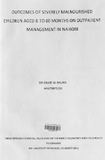| dc.description.abstract | BACKGROUND AND STUDY RATIONALE
Severe acute malnutrition remains an important underlying cause of morbidity and mortality for children under five years of age globally and locally. This study aims to evaluate the nutritional outcomes of the children on outpatient management, a concept who's adaption to the non-emergency settings has only been recently done.
METHODOLOGY
Objectives: The primary objectives of the study were to determine the mean weight gain (in g/kgJd), mean weight for height (WHZ scores) and mid-upper arm circumference (MUAC) over a 4 week period of severely malnourished children aged 6 to 60 months on outpatient management in Nairobi. Secondary objective was to determine the proportion of children being transferred to inpatient care; who died (mortality); who defaulted and who were discharged
home as having been cured. Study design: a prospective cohort study was carried out at Baraka Medical Clinic (Feeding Programme), Mathare valley in Nairobi between December 2009 and May 2010
Study procedures: A standardized questionnaire was used to collect data. Anthropometric measurements (weight, height, MUAC) and presence of oedema were taken at onset. The children were then started on RUTF, antibiotics, vitamin A as necessary and any other medicine they required. The children were followed up weekly but re-evaluation (clinical and anthropometrically) done after four weeks. The data was cleaned using Ms-Excel and analysed
using SPSS 17.0. P-value of less than 0.05 was considered significant.
RESULTS: A total of 133 patients were enrolled into the study. The me~n age of the study participants was 15.1 months (52.1% between 13-24months), with 57.1% ofthem being female. The average weight gain was 3.7 gjkgjd. The mean increase in weight-for-height Z score and MUAC are 0.86cm and 0.7cm respectively after 4 weeks of treatment and follow-up. Average weight gain was significantly higher in children who were reported to have consumed the entire
RUTF ration. There was an insignificant weight gain difference noted across different levels of education of the caregivers, illness of the child in the prior two weeks, and selected chronic illness (HIVjTBjRickets). The majority of patients were discharged from the aTP programme and were thereafter managed as moderately malnourished (57.5%) after four weeks of follow up and treatment. The mortality, transfer inpatient and default rates were 1.6%, 0.8% and 6.5% respectively.
CONCLUSIONS: The mean weight gain, mean increases in height, MUAC and WHZ score were statistically significant. The majority of children were discharged from the aTP programme during the period of follow up (58%). The mortality and default rates met the stipulated Sphere standards for management of severely malnourished children on an outpatient basis. | en_US |

